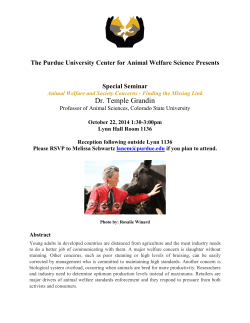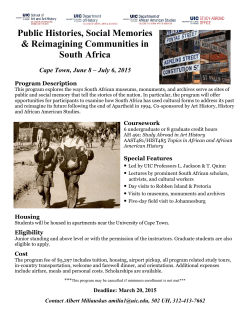
MN Child Welfare Considerations for African American Families
cases of child abuse and neglect as well as programs and practices available for families in the child protection system. Title IV-E Child Welfare Scholarship students of Metropolitan State University Social Work Department, with our professor and taskforce member, Robert O’Connor are will researching considerations that the committees of the Governor’s Task Force on Child Welfare has indicated as for possible best practices for working with African American families in child welfare. brought to the attention of child abuse and neglect within specific communities of color. Title IV-E scholar’s research entails the use of cultural helpers as well as cultural /evidence based practices for African American families, through the approach of exploratory research. MN Child Welfare Considerations for African American Families Tossia Brown, Barbra Elfstrand, Micheline Mutombo Floyd Harris, Shari Marik-Roach, Katie Peters, and Marcy Vang Faculty Mentor: Robert O’Connor, MSW College of Health, Community, and Professional Studies Abstract The state of Minnesota is currently undergoing a dramatic change to the Child Maltreatment law after multiple gaps in the Child Protection system surfaced. Governor Mark Dayton has assigned a Task Force to take on the lead on providing legislators with changes necessary to create a more effective Child Welfare system that will keep children safe. Title IV-E Child Welfare Scholarship students of Metropolitan State University Social Work Department, with our professor and taskforce member, Robert O’Connor, are researching considerations for possible practices for working with African American families in child welfare. Title IV-E scholar’s research entails the use of cultural helpers as well as cultural/evidence based practice for African American families, through the approach of qualitative exploratory research of scholarly literature collected. Research Question or Problem Statement Research Question: Can a Cultural Helper be an adequate person to insure best practices when working with African American families in Child Protection? • Pope County 2014: Death of 4 year old boy 15 reports to Child Protection – none of the reports were ever investigated • Children & Family Services: Minnesota’s Child Welfare Report 2013, American Indian and African American/Black children were more likely than children of other races to be involved with the child protection system. • This chart, provided by the Dept. of Human Services shows the Child in out-ofhome care compared to the MN child population by race. TEMPLATE DESIGN © 2008 www.PosterPresentations.com Cultural Helper A cultural helper: “a helper who can serve as sociocultural bridges between professional intentions and client expectations-not only equipped to interpret meanings of words drawn from two distinct languages and cultures, but also able to mediate between agencies and their clientele to access appropriate, relevant, and sensitive services (Owen & English, 2005)”. Best Practices Evidence Based Practice: “the use of the best available scientific knowledge derived from randomized controlled outcome studies and metaanalyses of existing outcome studies, as one basis for guiding professional interventions and effective therapies combined with professional ethical standards, clinical judgment, and practice wisdom (National Association of Social Workers, n.d.)”. May include the following roles: Paraprofessional Cultural Advisor Natural Helpers Cultural Broker Cultural Navigators Interpreters Themes • Positive: Outcomes, Statistic data Natural Helpers working with families at risk of abusing or neglecting their children survey of Natural Helpers level of effectiveness indicated, “That most [Natural Helpers] helps enhance the families’ problem-solving resources more than they diminished them. 58 percent of the helpers were considered a principal or important source of problem resolution, 39.7 percent were considered to be equally a source of and an impediment to the problem, 6.4 percent were thought to be principal or important impediments to problem resolution”. • Environment: Community Specific, Cultural Specific, Family Involvement Barker (1999) maintained that key aspect of community development is “to enhance the social bonds among members of the community” (p. 90). Thus, joining together in solidarity is an essential community development activity that facilitates community members’ understanding “that their individual problems have social causes and collective solutions.” • Strategies: Training, Kinship, Collaborations, and Services “The cultural brokers provided language interpretation, served as mediators, and offered information to the providers about the withingroup differences among the Hispanic population in their clinic. These cultural brokers also taught families about how the American health care system works and engaged them in teaching the providers about their cultures.” Analysis and Interpretation of Results • Cultural Helpers must be trained appropriately to ensure competency • Best Practices in itself is difficult to replicate within other communities of color • Best Practices should include community members who can help advocate for families • Cultural Helpers will represent multiple roles when working with families (advocates, interpreters, teachers, researchers) • Families found more comfort with cultural helpers in their case planning along with their Social Workers Themes • Roles: Advocacy, Social Support, Cultural Competency The American Psychological Association Task Force on Resilience and Strength in Black Children and Adolescents “used a social ecological model to show that black children’s growth is shown to include unique aspects that reflect the context of systematic marginalization in which they are raised”. “Family therapist can help marginalize families living in challenging context, develop skills as both navigators who access resources, as well as negotiators who are able to convince therapists and other service providers of what are culturally and contextually meaningful sources of support. Application of social ecological theory of resilience to family therapy requires decentering the therapist, and limiting the imposition of cultural bias toward definitions of problem and solutions.” “Many of the challenges of working within underserved communities maybe overcome by capitalizing on the strengths of paraprofessionals who may more easily identify with, recruit, and engage community members than professionals who may be more likely viewed as “outsiders” by community members”. Governor’s Task Force Updates “When it comes to child protection, the Governor will allocate $2.5 million in additional funds to oversight. This funding will go toward providing the state with additional full time equivalents (FTEs) to develop best practice protocols and training. Jim Koppel, assistant commissioner for Children and Family Services, talked at the House HHS Finance Committee meeting about inconsistency in child protection practice across Minnesota’s 87 counties. The proposals hope to better align county programs to lessen disparities in practices across counties. Based on recommendations from the Governor’s Task Force, changes to the child protection system will also include the development of protocols, bulletins, and databases that will better inform care and help make better decisions (Brubaker, 2015).” • Understand challenges that African American community face in order to develop an effective practice to prevent child abuse & neglect risks Conclusions • Governor’s Task Force on Child Welfare is quickly moving forward by implementing many changes into MN’s Child Welfare practices. • There is limited literature available that discusses culturally specific best practices within African American communities, as well as any other specific ethnic groups • Much of the literature suggests in order to provide effective services that have been proven to help reduce or serve African American families at risk of child abuse or neglect should involve cultural helpers within best practices. •Cultural helpers involvement does not replace a worker’s role, but provides cultural lens for both parties •Cultural helpers then represent the researchers behind best practices of child welfare – trained and competent •Involving more persons of different ethnic communities in child welfare decision making process •More discussion on how to work with African American families or other ethnic communities needs to be discussed Acknowledgements Ballew, J. R. (1985). Role of Natural Helpers in Preventing Child Abuse and Neglect. Social Work, 30(1), 37-41. Brubaker, A. (2015, February 3). Governor Dayton releases 2016-2017 Biennial Budget. Retrieved April 3, 2015, from http://cascw.umn.edu/policy/governor-dayton-releases-2016-2017-biennial-budget/#prettyPhoto Bronheim, S. (2011). Promising practices: Cultural brokers help families and providers bridge the cultural gap. National Center for Cultural Competence, Georgetown University Center for Child and Human Development: Washington, DC. Calzada, E., Caldwell, M., Brotman, L., Brown, E., Wallace, S., Mcquaid, J., O’Neal, C. (2005). Training Community Members to Serve as Paraprofessionals in an Evidence-Based, Prevention Program for Parents of Preschoolers. Journal of Child and Family Studies, Volume 14(Issue 3), 387-402. Children and Family Services: Minnesota Child Welfare Report 2013 (2014). Department of Human Services. Retrieved at: www.dhs.state.mn.us. National Association of Social Workers. (n.d.). Retrieved March 24, 2015, from http://www.socialworkers.org Schiele, J.H, Jackson, S.M., Fairfax, C.N. (2005). Maggie Lena Walker and African American community development. Journal of Women and Social Work. 20 (1) 21-38. Stahl, B. (2014). “Task force assails child protection for meager follow-up,” StarTribune. October 14. Ungar, M. (2010). Families as Navigators and Negotiators: Facilitating Culturally and Contextually Specific Expressions of Resilience. School of Social Work, Dalhouise University, Halifax, NS, Canada. Fam Proc 49:421-435
© Copyright 2025









